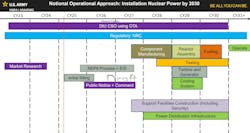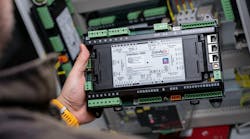DoD Taps 8 Nuclear SMR Vendors in Push to Deploy On-Site Microreactors: Data Center Energy Implications
The Defense Innovation Unit (DIU) is a specialized organization within the U.S. Department of Defense (DoD), established in 2015, that is dedicated to accelerating the adoption of commercial technology to enhance national security.
DIU's mission is to strengthen U.S. national security by accelerating the integration of commercial technology throughout the military and expanding the national security innovation base. By partnering with various DoD entities, DIU rapidly prototypes and fields advanced commercial products to address pressing national security challenges.
Innovating energy solutions is one of the six areas the unit focuses on; according to their website the unit describes their mission like this:
We award scalable contracts to companies offering solutions to national security challenges across a variety of technology areas.
With a mission to facilitate the integration of commercial solutions, DIU employs agile contracting methods such as the Commercial Solutions Opening (CSO) and Other Transaction Authority (OTA). These approaches reduce barriers for non-traditional vendors, enabling faster prototyping and deployment of technologies.
Advanced Nuclear Power for Installations (ANPI)
The Advanced Nuclear Power for Installations (ANPI) initiative is a collaborative effort led by the DIU in partnership with the U.S. Army and U.S. Air Force. Launched in June 2024, the program’s announced goal is to design, build, and deploy fixed, on-site microreactor nuclear power systems at select military installations to enhance energy resilience and support global operations across various domains, including land, air, sea, space, and cyberspace.
According to Dr. Andrew Higier, Energy Portfolio Director at DIU:
Projecting power abroad demands ensuring power at home and this program aims to deliver that, ensuring that our defense leaders can remain focused on lethality. Microreactors on installations are a critical first step in delivering energy dominance to the Force. Tapping into the commercial sector’s rapid advancements in this area is critical due to the significant private investment in this space over the last few years. The U.S. and the DoD must maintain the advantage and leverage the best of breed nuclear technology for our national security.
Eight Nuclear Vendors
In early April, the DIU announced eight vendors that had qualified for the program and its flexible funding authority. These eight vendors are tasked with demonstrating the ability to deliver compliant, safe, secure, and reliable nuclear power solutions suitable for military applications, a primary concern of which is data centers.
The competing vendors are expected to deliver microreactors capable of delivering between 3M W and 10 MW of power as a decentralized scalable microreactor system capable of producing enough electrical power to meet 100 percent of all critical loads. They are as follows:
BWXT Advanced Technologies LLC
General Atomics Electromagnetic Systems
Radiant Industries Incorporated
Westinghouse Government Services
A key stated component of this project is that is to: “Utilize the civil regulatory pathways of the Nuclear Regulatory Commission (NRC) to stimulate commercial nuclear microreactor technology development and the associated supply chains in the U.S.”
Where Do Current Projects Stand?
A number of these approved vendors were recently highlighted in a US Department of Energy blog from the Office of Nuclear Energy highlighting three microreactor developers that were working with the DOE at the Idaho National Lab. These three developers were expected to operate onsite as soon as 2026 and included:
- The Westinghouse eVinci Microreactor, a transportable microreactor utilizing advanced heat pipe technology and TRISO fuel, designed for deployment in remote locations without the need for water cooling.
- The Radiant Kaleidos Microreactor, portable 1.2-megawatt high-temperature gas-cooled microreactor intended as a diesel generator replacement, capable of rapid deployment in a single shipping container.
- The Antares R1 Microreactor, a design that will be passively cooled by sodium heat pipes and powered by robust TRISO fuel, with a 200-300 kW power target.
Westinghouse
Westinghouse is also aggressively pursuing development partners and potential users, with Westinghouse Electric Company and Urenco having signed a five-year agreement for the supply of high-assay low-enriched uranium (HALEU) to fuel Westinghouse's eVinci microreactor.
This partnership is pivotal in establishing a reliable fuel supply chain for advanced nuclear technologies. They also recently hosted a delegation of lawmakers from Pennsylvania at the eVinci Technology Accelerator in Etna, Pennsylvania.
The visit provided insights into Westinghouse's advanced nuclear technologies, including the eVinci microreactor, AP1000 GEN III+ reactor, and AP300 small modular reactor (SMR), highlighting Westinghouse's involvement in current and future nuclear power generation designs.
Discussions with the lawmakers focused on the economic benefits of nuclear energy for Pennsylvania and the potential role of these technologies in the state's energy future.
NANO Nuclear
While not on the current list of approved microreactor vendors for the APNI project, NANO Nuclear Energy Inc.'s KRONOS micro modular reactor is also in the news with the NRC approving their Fuel Qualification Methodology (FQM) Topical Report.
This approval establishes a regulatory framework for qualifying Fully Ceramic Microencapsulated (FCM) fuel, which incorporates TRISO fuel particles within a silicon carbide matrix. The FQM underwent joint review by the NRC and the Canadian Nuclear Safety Commission, with the UK's Office for Nuclear Regulation participating as an observer.
This milestone enables NANO Nuclear to proceed with the construction permit application for the KRONOS prototype at the University of Illinois Urbana-Champaign.
Military/Commercial Collaboration
As a collaboration between the DIU, US Army, and US Air Force, the target as described above is to use those commercial pathways to design, license, build, and operate at least one, and possibly many, microreactor power plants on US military installations.
Daniel Klippstein, Senior Official Performing the Duties of Assistant Secretary of the Army, Installations, Energy and Environment, stressed the importance of this effort, saying:
Advanced nuclear power represents a transformative opportunity to bolster Army installation resilience and strengthen national security in an increasingly uncertain world. Advanced microreactor designs are smaller, safer, and more efficient than their predecessors. The Army’s partnership with, and investment in, the domestic nuclear industry will reduce reliance on foreign energy supplies and ensure uninterrupted power for the Army’s defense mission.
The ANPI initiative aligns with several executive orders aimed at enhancing U.S. energy security and modernizing defense acquisitions including Executive Order (E.O.) 14156 – Declaring a National Energy Emergency and E.O. 14154 – Unleashing American Energy.
By integrating advanced nuclear power technologies, the program seeks to ensure uninterrupted power supply for critical military missions, strengthening national security and reducing reliance on foreign energy sources.
Deputy Assistant Secretary of the Air Force for Infrastructure, Energy, and Environment, Nancy Balkus highlighted these goals, saying:
U.S. energy dominance and security are more critical than ever, especially in supporting Air Force and Space Force missions. To ensure our installations can respond at a moment’s notice, we must strengthen our lethality by accelerating the deployment of emerging technologies like advanced nuclear energy - delivering reliable, cost-effective, and secure power to our bases.
With the ANPI program's focus on working with commercial industry providers, one of the targets is to encourage the development of domestic nuclear microreactor technology and associated supply chains.
The idea is to utilize civil regulatory pathways already established and being developed by the NRC, while leveraging the rapid advancements in commercial nuclear technology in order to accelerate the deployment of advanced nuclear energy solutions within the Department of Defense.
Applying the flexibility in the Other Transaction funding model, which encourages multiple players, and different approaches to problem solving, the military can work hand in hand with commercial nuclear vendors in developing solutions beyond the direct military need - such as data centers.
The image below shows the planned implementation timeline with full operation by 2031:
Implications for the U.S. Data Center Industry: A Strategic Realignment Around Energy Resilience and Public-Private Innovation
The Department of Defense’s ANPI initiative, spearheaded by the Defense Innovation Unit, signals far more than a military infrastructure upgrade—it marks a seismic shift in how the U.S. will think about power reliability, national security, and digital infrastructure in the years ahead. With microreactors being explored specifically as a power solution for critical installations—including data centers—the implications extend directly to the heart of the country’s digital economy.
Over the past year, data center developers have grown increasingly vocal about the energy bottlenecks throttling hyperscale expansion across key U.S. markets. Recent examples include Dominion Energy’s multiyear delays for new grid interconnections in Northern Virginia and ERCOT’s strained capacity amidst booming AI data center growth in Texas. While utility-scale solar and grid batteries are part of the solution, they are not near-term fixes for high-density workloads that require 24/7, dispatchable power. This is where advanced nuclear—particularly modular microreactors—enters the conversation as a serious contender.
The DoD’s ANPI initiative offers the strongest signal yet that microreactors are ready to move from concept to implementation. With regulatory, commercial, and defense interests aligned, the U.S. government is now actively underwriting the development of a nuclear microreactor supply chain that could soon benefit commercial industries facing similar challenges. By deploying these technologies first on military bases, the government effectively de-risks early-stage projects, paving the way for broader commercial adoption—including for data center campuses that are outgrowing the capabilities of traditional utility service areas.
In parallel, the Executive Branch has in recent years been aggressively pushing for government-wide modernization of federal IT infrastructure and mission-critical facilities, including data centers. The White House Office of Management and Budget (OMB) recently issued guidance under its Federal Data Center Optimization Initiative 2.0 (DCOI), with strong emphasis on improving energy efficiency and exploring alternative power models.
Similarly, the Department of Energy's LPO (Loan Programs Office) is funneling billions into advanced nuclear and other resilient energy technologies that can support critical infrastructure. These federal policies align closely with ANPI’s goals—and may soon help support pilot deployments of microreactors not just on bases, but also for federally supported data center hubs.
A Nuclear Lifeline
Moreover, the commercial momentum around microreactors is accelerating. Westinghouse, Radiant, and Antares are not simply building for government customers—they are actively building dual-use models that could plug into private sector operations. Westinghouse’s eVinci reactor is already being positioned as a clean energy solution for edge data centers and mining operations in remote areas. Radiant’s Kaleidos, with its single-container portability and high-temperature gas cooling, is ideally suited for high-density compute loads in areas with poor grid resilience.
For the U.S. data center industry, especially hyperscale and AI-driven workloads, this emerging convergence between defense-funded R&D and commercial deployment pathways offers a potential lifeline. As land and power constraints become the defining factors of site selection, data center operators will be forced to think creatively—about colocation with military infrastructure, about private-military partnerships, and about integrating alternative energy into their base designs from day one.
The implications ripple through policy, siting, and investment strategy. Municipalities and economic development groups may begin to court microreactor-powered data center developments with the same enthusiasm previously reserved for solar fields or semiconductor fabs. Investors, meanwhile, are likely to see a boost in advanced nuclear valuations, particularly for vendors tied to dual-use programs like ANPI.
Conclusion
Ultimately, the ANPI program is not just about keeping military installations online during a crisis—it’s a testbed for reshaping the power architecture of America’s digital backbone. And if it succeeds, it may well define a new playbook for how the U.S. builds and powers data infrastructure in an era of both geopolitical uncertainty and explosive compute demand.
The intersection of national security, energy resilience, and digital infrastructure is where the next great wave of innovation is unfolding. And it may very well be nuclear-powered.
At Data Center Frontier, we talk the industry talk and walk the industry walk. In that spirit, DCF Staff members may occasionally use AI tools to assist with content. Elements of this article were created with help from OpenAI's GPT4.
Keep pace with the fast-moving world of data centers and cloud computing by connecting with Data Center Frontier on LinkedIn, following us on X/Twitter and Facebook, as well as on BlueSky, and signing up for our weekly newsletters using the form below.
About the Author

David Chernicoff
Matt Vincent
A B2B technology journalist and editor with more than two decades of experience, Matt Vincent is Editor in Chief of Data Center Frontier.




